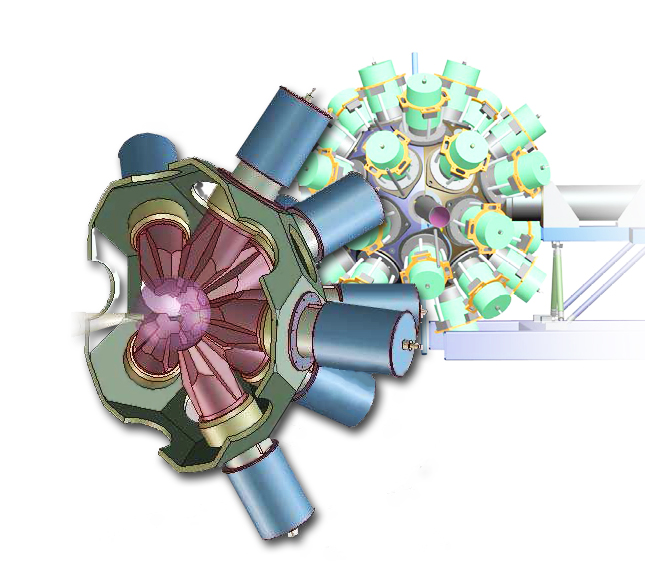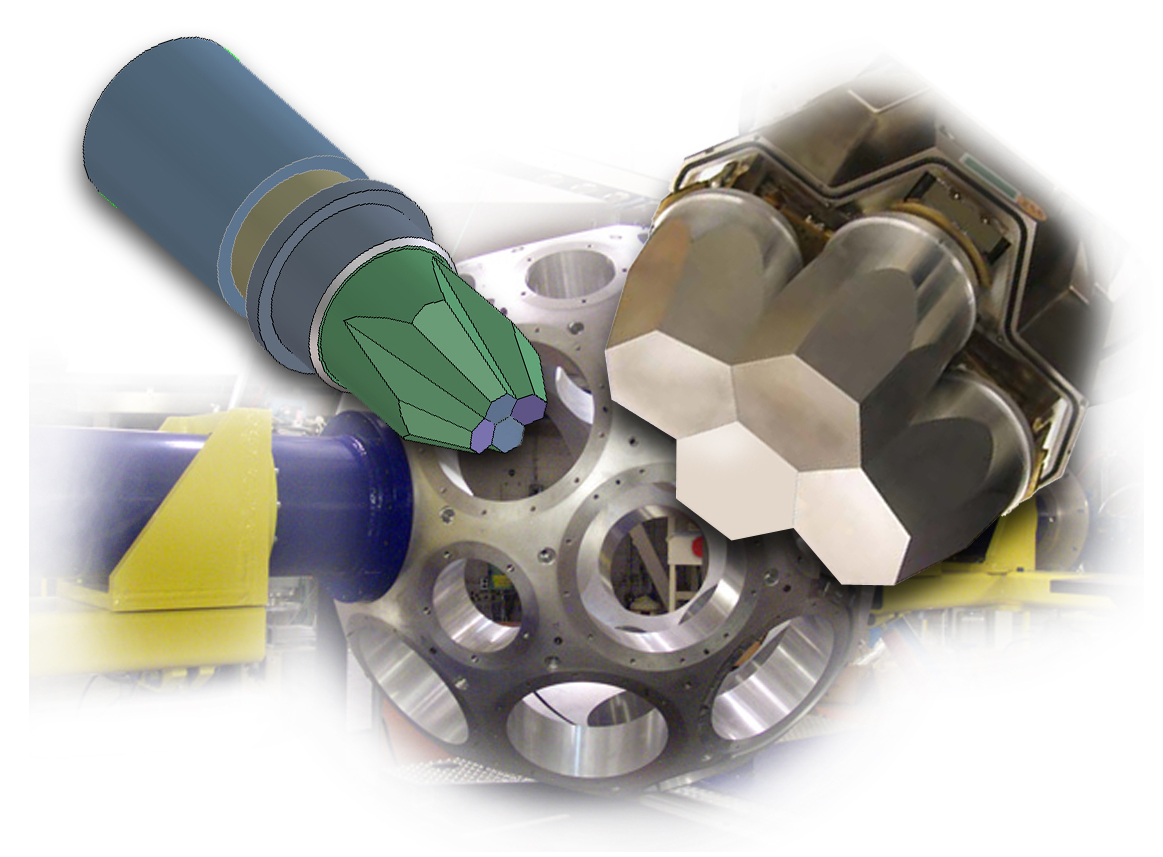
Sketches of GRETINA (foreground) and GRETA suggest how GRETINA’s seven detector modules will eventually expand to a full 30 modules to provide complete spherical coverage of the central interaction region. GRETA will be one of the premier detectors for the Department of Energy’s Facility for Rare Isotope Beams.
Part of what fascinates scientists about nuclear physics and chemistry is learning just how the natural elements came into being. All the elements heavier than iron – over three-quarters of the entries in the periodic table – were created by exploding stars. While their collective mass adds up to a miniscule fraction of the total matter in the universe, without them the universe would be lifeless. Equally fascinating are the rare, human-made superheavy elements, with their promise of an “island of stability” far beyond the masses of the natural elements.
Since one of the best ways to study nuclei is to catch the gamma rays they emit as they spin or undergo transmutations, gamma-ray detectors hold the keys to understanding not only nucleosynthesis in stars and supernovae but artificial superheavy elements as well.
With a little help from its friends in universities and national laboratories, Berkeley Lab builds some of the best gamma-ray detectors in the world. The Gammasphere now at Argonne National Laboratory, the world’s most powerful spectrometer for research in nuclear structure, was built here, and a far more sensitive and precise detector named GRETINA, now being assembled, is gradually taking up occupancy in Cave 4C at the 88-Inch Cyclotron.
GRETA and GRETINA
“GRETINA will eventually grow up to become GRETA, the Gamma-Ray Energy Tracking Array,” says I-Yang Lee of the Nuclear Science Division (NSD), who heads the GRETINA program and was a leading member of the team that built the Gammasphere. “Someday GRETA will have 30 detector modules mounting 120 crystals, whose concave faces will form a hollow sphere surrounding the central experimental region. Even though GRETINA uses just seven modules and encloses only a fourth of a sphere, it will still greatly outperform the Gammasphere for many applications.”
Lee and his colleagues will be spending the remainder of 2010 painstakingly assembling the components of GRETINA in Cave 4C and submitting the entire system, including the detector itself and its signal processing and analysis facilities, to rigorous engineering tests. Not until the spring of 2011 will GRETINA be complete, able to tackle its first nuclear experiments.
The key to using gamma rays to reveal nuclear shapes, structures, and other properties in detectors like GRETINA are large, hyper-pure germanium crystals, which gamma rays can penetrate deeply before being absorbed. Each gamma ray absorbed by a crystal emits a signal that’s picked up by the system’s electronics. But the largest crystals that can be grown commercially are only about three inches long and three inches wide – so small that gamma rays can fly right through them.

High-purity germanium crystals whose faces are shaped to form a perfect sphere are the keys to detecting as many gamma rays as possible with the highest sensitivity and resolution. Each four-crystal module is cooled by a dewar of liquid nitrogen. Eventually the machined aluminum shell will accomodate 30 such modules.
GRETINA’s solution is to pack numerous pure crystals close together in its modules so that any gamma ray entering a crystal can be tracked even if it stops in the crystal next door. GRETINA can measure signal energy and resolve the point of gamma-ray absorption to within a millimeter – astonishing accuracy, considering the very long path gamma rays must follow between leaving the nucleus and entering the detector several inches away.
Precise tolerances are essential at every level, from the tight packing of the crystals in the module to the curvature of the module faces, the machining and alignment of the half-spherical aluminum shells that hold the modules, and the insertion of the modules in the shells.
“The half-shells are carved from single blocks of aluminum ‘tooling plate,’” says Lee. “Heat treating gets rid of internal stress, so the shells and their mounting rings and threads hold very precise tolerances.” The shells, designed by a team lead by Steve Virostek of Berkeley Lab’s Engineering Division and manufactured by Martinez & Turek, Inc., are calibrated upon arrival by Engineering’s Bob Connors, using a Zeiss Accura coordinate measuring machine that can locate any point on a three-dimensional surface to within three micrometers (millionths of a meter).
Before mounting in the shell, the modules are fully bench-tested upon arrival from their manufacturer, Canberra Eurysis. Trials include cooling the detectors to liquid-nitrogen temperature to check physical tolerances, assessing crystal quality, and checking the electronics, partly by inducing the modules to emit test signals, a process monitored by Engineering’s Carl Lionberger, who is in charge of GRETINA’s computing systems.
So far two modules have had to be returned to the manufacturer for “microphonics,” excess sensitivity to noise, which can cause the detector to act like a microphone and emit false signals. Of GRETINA’s set of seven, these two modules and one new one are still to be delivered; three are at Berkeley Lab, and one is being tested at Michigan State University, a member institution in the GRETINA collaboration.
The GRETINA support rig is designed to make module insertion as easy as possible. The aluminum half shells are mounted on axles that move in and out and rotate to receive the modules. New Gorbel jib cranes mounted beside GRETINA in Cave 4C can sense a human’s guiding hand as the equipment is moved into place. Final tweaks are done with sets of struts that aim the axles; these are repeatedly hand-turned according to iterated instructions from a computer, until laser beams bouncing off position reflectors signal alignment to within two-tenths of a millimeter.
“The two halves we’re installing in Cave 4C don’t make a perfect sphere,” says Lee, “because our initial series of tests includes a large magnetic spectrograph on the downstream end of the beam. To accommodate it we had to take a slice off the side of the sphere. This ‘beta test’ version of the complete shell can accommodate 21 modules, although we’re starting with only seven; the full GRETA will have a completely spherical shell and will hold 30 modules.”
Signals from the nucleus
Once in place, each module sprouts a bundle of wires, including a high-voltage power cable, a control cable, and four cables that send signals to an electronics facility, which is overhead on the cyclotron’s concrete-block roof.
The majority of the electronics modules in the facility are designed by a team lead by Engineering’s Sergio Zimmermann. They comb through 10 million signals per second, taking 10-nanosecond samples and digitizing the data before sending it on to a computer cluster on the ground floor of the building. Since signal shapes will be the key to determining where gamma rays are absorbed in the numerous crystals, revealing the precise x, y, and z coordinates of each hit, GRETINA detector and installation team leader Augusto Machiavelli is working with Stefanos Paschalis and Jing Qian to tune the electronics system’s responses to artificially produced signals of various shapes in advance of the actual tests.
Downstairs, next to GRETINA’s control room, the signals are processed by a cluster of 62 computers, each with two central processing units. Highly efficient algorithms are able to perform multiple tracking of up to 20,000 gamma rays per second. Four CPUs, each with four cores, are uniquely dedicated to each one of the crystals in GRETINA’s modules. There’s so much redundancy in the system, says Lee, “that when one of the computers went bad we hardly noticed.”
The computer cluster also includes 40 terabytes of duplicate storage. GRETINA team member Mario Cromaz says, “it’s one of the few experiments I’ve seen that uses 40 terabytes just while calibrating.” Months of calibration on all systems remain before GRETINA will be ready for science.
“After engineering runs in Cave 4C are completed early in 2011, we’ll move GRETINA to Cave 1, the home of the Berkeley Gas-Filled Separator,” Lee says. The Berkeley Gas-Filled Separator (BGS) is designed to study nuclei of heavy elements created when the 88-Inch Cyclotron’s powerful ion beam sends one elemental species into a target made of another species, then examines their decay products or chemical properties.
GRETINA adds a whole new method of study to the capabilities of the BGS. “We’ll be able to perform the best gamma-ray spectroscopy of heavy element 102, nobelium, element 103, lawrencium, and element 104, rutherfordium,” Lee says.
After its work at the BGS, GRETINA will go on the road to visit several of the nation’s leading nuclear science laboratories, spending six months each at Michigan State University, Oak Ridge National Laboratory, and Argonne National Laboratory before returning to Berkeley Lab in 2013.
GRETINA is a collaboration among Berkeley Lab, Argonne, Michigan State, Oak Ridge, and Washington University. Scientists from these and numerous other institutions have contributed to the design and construction of GRETINA.
Additional information
More about GRETINA
GRETINA’s progress